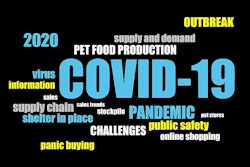
U.S. pet food sales data released over the past month showed significant surges as pet owners stocked up in reaction to being quarantined or directed to shelter at home, as cases of COVID-19 began accelerating throughout the country. Some market experts predicted the sales rise wouldn’t last – were they correct?
New data provided on April 22 during a webinar organized by the American Pet Products Association (APPA) helps answer that question, along with providing details on the types of pet foods being purchased.
Pet food sales decline in early April
In late March, Nielsen reported that for the week ending March 21, dog food sales had increased 54.7% over the previous year, following a 37.5% gain the week before. Similarly, cat food sales rose 52.8% and 38.7% for the respective weeks. At the time, Maria Lange, VP of strategic verticals pet and cannabis for Nielsen, said she believed pet owners had stocked up on about two months’ worth of food and predicted a large decline (at least in brick-and-mortar stores) in the second quarter of 2020.
During the APPA webinar, Lange shared pet food sales data for the final week of March and first week of April, showing declines of 7.8% and 14%, respectively, in brick-and-mortar stores. This followed similar volatile patterns in overall pet care sales as well as other consumer goods categories, such as baby care, household care and health and beauty, Lange said. (Interestingly, while alcohol sales also dipped after a mid-March spike, they’re still significantly higher than for the same weeks in 2018 and 2019!)
Unsurprisingly, dry pet food saw the largest spike mid-March, at least in brick and mortar stores, according to Nielsen data; larger bags of dry dog food (more than 28 pounds) experienced the biggest increase. Those large dogs eat a lot, so their owners will have to buy again before long. Lange indicated another pet food purchasing cycle was likely, perhaps especially for wet food and treats, though it may not be what was considered normal before the COVID-19 pandemic.
Dry pet food sales also increased the most online (84%), but wet pet food was not far behind at 77%. Pet treats showed 57.6% growth in March online. Lange did not provide online sales data past March but speculated whether it would continue to gain even more momentum after the crisis.
(Note: Lange’s colleague, Sean Simpson, client insights and consulting for Nielsen, will present another pet food market update during a Petfood Industry webinar on May 7, 2020. Bookmark this page for more information.)
Pet retailer’s perspective: what’s next for pet food
Another speaker for the APPA webinar, Brannon Dixon, CEO of pet retailers Feeders Supply and Chow Hound Pet Supplies, provided even more data and detail on the types of pet food being bought in March, at least by his customers.
Sales of dog and cat food spiked 60% in his stores in early March, then also dipped during that last week of March/first week of April period – except the stores also saw sales starting to “curve back” leading up to Easter, especially for wet cat food. During the sales surge, Dixon’s customers stocked up on case packs of cans of both dog and cat food, he said, plus larger bags of dry food.
While in-store traffic declined 20%, he said, basket sizes increased by more than 16%. But where his stores’ sales growth came from was online and mobile orders – what he called omnichannel. For home delivery orders, the basket size more than doubled from pre-pandemic orders, while overall home delivery orders more than tripled. Similarly, the stores’ website traffic, social media engagement and email open rates increased significantly.
Dixon believes the pandemic and resulting stocking up by pet owners shifted some from the FDM (food, drug and mass) channel to pet specialty, at least initially, due to the latter channel being more focused on pet food and having more products in stock. Perhaps this was because pet foods made by the “diversified product conglomerates” focused on their human-based brands over their pet brands, he speculated, leading to stores like his gaining “loyalty” customers and more customers overall.
Another draw during this crisis for pet specialty stores like Dixon’s has been their ability to ramp up home delivery and curbside pickup. In fact, he said, customers seemed willing to substitute brands for the convenience of being able to order them for home delivery or outside pickup.
The bottom line for pet specialty retailers, according to Dixon: Market share is “up for grabs.” He recommends that other pet retailers focus on their core items and pet food brands, along with their inventory fill rates; consider extending promotions; and prepare for a second wave of stocking up.
Path forward for pet specialty post-COVID-19?
Despite Dixon’s optimistic outlook – understandable, given his businesses – other pet market experts have speculated that the current crisis could spell impending doom, even a death knell, for much of the pet specialty channel, especially independent pet stores. That channel was the only one in the U.S. pet care market not to experience growth in 2019, according to Packaged Facts. Meanwhile, pet food and pet care e-commerce only continues to increase, and the pandemic will likely fuel that growth, as many consumers who had been only occasional online shoppers might decide they like it and stick with it.
Yet Dixon’s experience to date, among that of other pet specialty retailers, and his learnings may provide a path forward for the channel on the other side of this crisis. That could be vital for pet food companies, especially those with smaller, more specialized brands that have catered to the channel. Even as other companies are successfully expanding into other channels, including online, there is very likely still a place, and market share, for the neighborhood pet shop that has long been the lifeblood of the pet food market and a favorite destination for many pet owners.
View our continuing coverage of the coronavirus/COVID-19 pandemic.
















